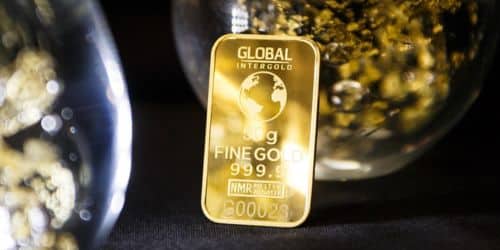Gold investing comes in many forms. From physical coins and bars, to buying stocks of companies that mine gold – though their values don’t move with its prices as closely.
It’s a Safe Haven
Gold (Au) can serve as a safe haven during times of political or financial upheaval, providing investors with protection against market declines and stabilizing portfolios during volatility, while safeguarding purchasing power against inflation. Furthermore, investing in gold may diversify portfolios while decreasing overall risk profiles.
This type of investing does carry some risks and drawbacks, so it is wise to weigh all available information before making a decision to invest. Before investing, investors should consult a trusted advisor for tailored advice tailored specifically to their unique circumstances and ways of investing.
Au coins or bars are the traditional method for investing in Au. While this form of holding can provide excellent returns on your investment, they can also be costly to store and transport, not being as liquid as stocks or bonds as well as not offering protection from currency risk.
ETFs and mutual funds offer an easy way to diversify your investments with gold-based assets. Due to their low correlation with stocks and bonds, ETFs and gold or silver IRA funds may serve as an effective defense against market declines. Not only that, but they may function as well as offsetting the effect of rising interest rates – while providing short-term gains as an added bonus.
Although investing in gold through futures contracts or options may seem attractive, such investments involve considerable risk and could cause the value of your holdings to significantly decline if its price decreases.
As investing all your eggs in one basket is always risky, stock market crashes could wipe out much of your wealth if it were fully invested. That is why diversifying with other types of assets, like Au – known for providing security during difficult economic times – should also be part of your portfolio strategy.

It’s a Store of Value
Au’s long history of stability and value makes it an attractive asset that remains resilient during economic turmoil. By adding gold to your portfolio, it may help lower volatility and enhance risk-adjusted returns; however, such investments should only ever form part of an overall diversified investment plan; the risks involved with physical storage, insurance costs and low correlation with stocks make them unsuitable standalone investments.
Investors can also purchase Au coins and bars, which are smaller versions of bullion that typically contain different proportions of Auto silver. They’re priced according to a “premium” charged over their actual gold price which varies based on dealer and location; smaller products tend to cost more due to manufacturing, packaging and distribution expenses.
Physical gold does not produce cash flow and it can be hard to tell when its prices have increased or decreased, making its purchase unattractive and risky. Therefore, adding it as part of your portfolio in limited amounts should be done with great caution; while gold may serve as an effective hedge against declining stocks, its correlation may not always inversely correlate; therefore it should always be included as part of a well-diversified portfolio.

It’s a Diversifier
Au investing can add diversification to your portfolio by helping to balance market swings. Furthermore, it serves as a hedge against inflation. Unfortunately, buying and selling Au requires active management as it does not generate passive income such as dividends or interest, therefore necessitating active decisions regarding purchase/sale decisions and possible loss in value over time.
Although there are various ways to invest in gold, one of the most popular methods is purchasing physical bullion. This strategy offers several advantages such as diversifying your portfolio without compromising liquidity, being easily resalable and cutting trading and holdings fees – however investing in gold may not come cheap; therefore it should be carefully considered when adding it to your mix.
Au can help protect against several risks, such as political uncertainty, economic volatility and rising interest rates. Au also offers diversification in times of economic crises – its price tends to increase when other investments decline while it can offer stability during periods of high inflation.
Gold’s primary appeal as an investment tool lies in its ability to protect against economic slowdown (https://www.quora.com/Why-is-gold-a-good-investment-during-a-recession-when-I-thought-it-was-a-better-investment-during-inflationary-periods) protect currency depreciation and manage political unrest – thus making it an excellent complement to stocks and bonds in your investment portfolio.
The fact that it has non-correlation with equity markets makes it an effective portfolio hedge against risk when stocks decline rapidly, providing additional protection.
Its role as a diversifier is especially essential amid increasing political and economic volatility globally. According to BullionVault, hypothetical portfolios that included gold alongside shares and bonds would have outshone similar portfolios since 1997; however, these figures do not take into account taxation, trading or holdings fees which may reduce diversification benefits.

It’s a Hedge
Gold as an investment can be an attractive strategy to diversify a portfolio, yet it is crucial that investors understand its risks before beginning this venture. Assess your personal risk tolerance and investment goals prior to purchasing precious metals from any dealer; select only reliable sellers; avoid high-pressure tactics or unsolicited calls as these could indicate fraudulence in business dealings.
Gold has long served as an effective hedge against equity volatility and inflation. Many investors hold onto physical precious metals as a protective hedge, yet there are other methods available to them that offer more reliable protection from inflationary risk and currency risk than buying physical bullion. TIPS issued by various governments or explicit currency futures purchases offer better opportunities.
Gold’s antidote for market downturns lies in its relationship to the stock market; during times of financial distress, stocks typically decline while precious metals spikes in value as people seek refuge in its safety in volatile economic environments. Still, diversifying your investment portfolio based on your goals – be that physical precious metals ownership, mutual funds or ETFs with precious metals holdings or derivatives can provide optimal protection.
This type of investment offers several key advantages over its alternative options such as public equities and bonds, including its independence from stock market fluctuations and positive correlation to inflation and interest rates – it also serves as an excellent store of value; however, the price fluctuates depending on supply/demand dynamics as well as geopolitical events.






